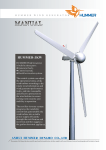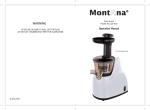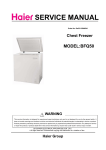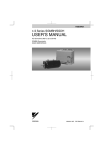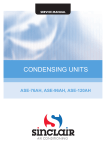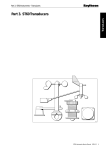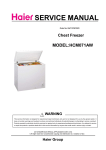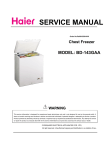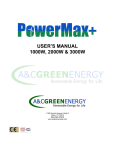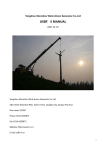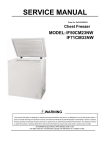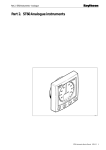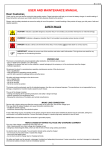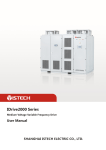Download User`s Manual - Residential Wind Turbines
Transcript
User's Manual Revised version: Ver 5.3 Applicable Model: 50KW Wind Generator and Yaw Shaft CONTENT 1. Product Structure 2. Description of System Function 2.1. Dogvane 2.2. Annemometer 2.3. Wind Generator Direction-Regulating 2.4. Manual Tracking Function 2.5. Time Needed for Direction-Regulating 2.6. Hydraulic Brake 2.7. Wind Generator Schematic Circuit 2.8. Wire Connection Diagram of Yaw Shaft and Generator ( 1) 3. 4. 5. 6. (5) Cable for Transmission and Control Communication Technical Parameter Power Curve of 50KW Wind Generator 50KW Wind Generator Assembly 6.1. Blades Assembly 6.2. Take Out Yaw Shaft 6.3. Connection of Generator Body and Yaw shaft 6.4. Connection of Two Towers 6.5. Connection of Generator and Tower 6.6. Wire Connection of Generator and Yaw Shaft 6.7. Assembly of Lightning Rod and Dogvane 6.8. Assembly of the Bottom Yaw Shaft Protection Cover (2) (6) (7) (7) 7. Erect the Tower 8. Assembly Precautions 9. Daily Maintenance 10. Safety Precautions 11. Troubleshooting (16) 12. 50KW Yaw Shaft Power Box 12.1. Structure Diagram 12.2. Instruction of Connected Switch, Terminal Blocks and Wire Connection 12.3. Wire Connection Diagram of Power Box and the Whole System 13. Annex: Anemometer Assembly (21) (18) (19) (20) (20) (23) 1. Product Structure 50KW wind generator consists of generator body and yaw shaft . The generator body consists of generator, blades, brake pad, etc.. Yaw shaft system has the direction-regulating function and it consists of gearbox, directionregulating DC motor, dogvane, hydraulic braking system, etc.. The Components listed as the following drawing. 18 1 19 2 3 4 5 6 7 8 20 9 21 10 11 12 13 14 15 16 22 23 24 17 Name NO. Name NO. 1 Blades 13 Hydraulic brake assembly 2 Generator 14 Braking stroke switch 3 Nose cone 15 DC motor wire connector 4 Lifting lug of the generator 16 DC24V hydraulic braking motor 5 Blade pressing plate 17 Braking grade probe 6 Brake pad 18 Upper yaw shaft protection cover 7 Brake caliper 19 8 Gear box 20 Seal cover Dogvane 9 Wind generator output cable terminals 21 Lightning rod 10 Yaw shaft angle probe 22 Yaw shaft baseplate 11 DC Direction-regulating motor 23 Signal wire terminal 12 Pressure gauge 24 Bottom yaw shaft protection cover 1 2. Description of System Function 50KW wind generator is directly driven by rotor blades without any other speedup equipment . The patented generator with high efficiency settles in front of the rotor blades, which is helpful to radiate heat. 50KW wind generator system consists of the following 9 parts: generator body (including rotor blades), yaw shaft, yaw shaft power box, tower, wind generator PLC controller, rectifier/dumping controller, inverter, dump load, energy storage components (battery bank or state grid). 2.1. Dogvane : It receives wind signal, indicates wind direction, and reads the average value of the angle measured by dogvane every 120s. If the angle read by dogvane is larger than 10°, wind generator controller will drive DC direction-regulating motor with yaw shaft to deviate to fulfill the function of facing wind automatically. 2.2. Anemometer : It measures wind speed. If the measured wind speed is over the start-up wind speed wind generator requires continuously within 30s, the auto wind direction tracking system will start up and the controller will drive DC regulating-direction motor to seek wind direction automatically. When the blades are facing wind direction, they can receive the maximum wind energy, and when the blades are parallel to wind direction, they can not receive any wind energy and stop running. CAUTION: The factory-set start-up wind speed value of wind generator is 1m/s. If wind speed is less than the required start-up wind speed value, the system will keep in standby mode. Users can change the start-up wind speed of wind generator in the "User Parameter Setting" window according to actual needs. 2.3. Wind Generator Direction-Regulating When blades rotate too fast owing to high wind speed, the controller will alarm for "over rotation speed". And the controller will drive DC direction-regulating motor with yaw shaft to deflect about 30° off wind direction at this time. If the blades still rotate too fast, the controller will further drive blades to deflect 60° off wind direction and then the blades will be parallel to wind direction and stop running. In 5 minutes, the controller will drive DC direction-regulating motor to seek wind direction again. If the alarm signal isn't released, the blades will keep parallel to wind direction.The controller will drive DC direction-regulating motor to make the blades deviate 90° and parallel to wind direction if any of below situations occurs. 2.3.1. When the wind generator's temperature is up to 145℃ , the controller indicates "over temp" 2.3.2. When wind speed is over the "system alarm wind speed", the controller indicates "over wind speed" CAUTION: All above functions are based on the "Auto" mode. 2.4. Manual Tracking Function Select "Manual" window on the screen of the controller, click "Mode switch", and then the track mode will be switched from "Auto mode" into "Manual mode". Under "Manual" mode, 2 when users press the anticlockwise-rotation or corotation buttons, yaw shaft will stop at any angle of -270°~ +270° to realize the function of Manual Tracking. CAUTION: When wind speed is over than 18m/s, in order to protect the wind generator system from any unpredictable damage, users can use "manual track" to set the blades aside or back to wind direction which can make wind generator stop working or set the blades 30°~ 45° off wind direction. In this way, wind energy received by the blades will decrease and rotation speed will slow down. 2.5. Time Needed for Direction-Regulating 2.5.1. It takes about 13 seconds for yaw shaft with the blades to deflect 30° off wind direction. 2.5.2. It takes about 38 seconds for yaw shaft with the blades to deflect 90° off wind direction. 2.5.3. It takes about 150 seconds for yaw shaft with the blades to rotate a circle (360°). 2.6. Hydraulic Brake Under heavy wind, the blades rotate too fast. Users can also switch into manual mode of wind generator controller and start up the function of "Hydraulic brake" to make hydraulic brake calipers lock the blades which will stop the blades from rotating. Or under manual mode, click "Manual stop", wind generator will deflect 90° and stop operation, then hydraulic braking will meanwhile start up and the brake calipers lock blades. 2.7 Wind Generator Schematic Circuit Temperature sensor of wind generator AC220V(or DC260~DC320V) (+) L Anemometer sensor (-) N Temperature transmitter Generator rotation speed sensor Yaw shaft deflection angle sensor Rectifier Stroke grade transducer DC 24V power supply I Dogvane sensor Pressure sensor SIEMENS PLC Wind generator DC 24V hydraulic brake motor Relay Load Directionregulating motor 3 DC 24V power supply II Relay Inverter Fuse Fuse 2.8. Wire Connection Diagram of Yaw Shaft and Generator Nose cone Generator body Wind generator output cables Wire connector B U2 U2 V2 Wind generator temperature wires Temperature transducer V2 U1 V1 U1 V1 Wire connector A To V- Brake motor 21 PE 2 V+ Lightning rod 5 1 V+ V- V- NC 7 6 4 19 20 G. W. G. Direct Temp. Direct Speed Grade Pressure W. V+ Direct V- 4 Signal wire terminal block Dogvane Wind generator rotation speed wires to power box 101 102 Y101 Y102 Brake assembly Pressure transducer Directionregulating motor Wind generator signal wires (total 13 wires, 1-7,17-21,PE) Gearbox After the mechanical connection of wind generator and yaw shaft, the generator body is required to connect the transmission and communication cables on the yaw shaft and then wind generator will operate normally. During this process, the following cables are required to be connected: four wires of wind generator output cables (U1/V1,U2/V2) ; three wind generator rotation cables; three wind generator temperature cables and three dogvane cables. Please connect as the following steps and the wire connection diagram. 2.8.1. Connect 3 wind generator temperature wires (Temp1/Temp2/Temp3) into the temperature transducer according to the signs. Temp1 connects to the upper terminal, Temp2 connects to the middle terminal, and Temp3 connects to the bottom terminal. 2.8.2. Connect 4 wires (U1/V1,U2/V2) of the two main output cables separately to terminal A/ B and tighten them. 2.8.3. Connect 3 wind generator rotation speed wires (G. Speed /V+/V-) to the Signal Wire Terminal Block 2.8.4. Put on the upper yaw shaft protection cover, assemble the dogvane onto the support pole, and then connect 3 dogvane wires (W. Direct /V+/V-) separately to the Signal Wire Terminal Block under the yaw shaft baseplate. Cables Wind generator output cables Wind generator temperature wires Wind generator rotation speed wires Dogvane wires Connect to Terminal Mark U1 V1 U2 V2 Temp1 Temp2 Temp3 Wire connector A Wire connector B Temperature transducer G.Speed VV+ W.Direct + - 1 2 3 Signal wire terminal block Dogvane wire terminal block VV+ U1 V1 U2 V2 Upper Middle Bottom G.Speed VV+ W.Direct VV+ 3. Cable for Transmission and Control Communication There are four main cables for 50KWwind generator extending outward from the below part of yaw shaft, as shown in the following picture. Two are wind generator output cables with the specification of 2*25mm 2 for each one. One is power supply cable for DC direction-regulating motor and hydraulic braking motor with the specification of 4*1mm 2. 5 2 The last one is signal cable for yaw shaft and power box with the specification of 12*0.3mm . 9 wires of them are for generator rotation speed signal, generator temperature signal, yaw shaft rotation angle signal, dogvane signal, hydraulic braking signal, the positive and negative power wires. In addition, connect the external shield metal netting of signal wires together as a ground cable to prevent from being disturbed during signal transmission. L+(DC220V) Power wire of direction -regulating motor M V+(DC 24V) Power wire of hydraulic braking motor V- U1 Wind generator V1 output cables U2 V2 Signal transmission wires 12*0.3mm2+PE 4. Technical Parameters Rated power(W) 50000 Maximum output power(W) 75000 Charging voltage (V) DC 360V Blade quantity (PCS) 3 Rotor blade material GRP Rotor blade diameter (m) Start-up wind speed (m/s) Φ12 Rated wind speed (m/s) 11 Rated rotating rate (r/min) 150 Wind energy utilizing ratio (Cp) 0.42 Generator output (double) Single-phase frequency conversion AC Rated charging current (A) 139 The maximum charging current (in a short time) (A) 208 Output AC frequency (Hz) 0~400 Generator efficiency >0.92 Wireless tower specification (mm) Φ1350× Φ530×18000(2segments) Tower height(m) 18m Generator weight (kg) 1200 2.0 6 5. Power Curve of 50KW Wind Generator 6. 50KW Wind Generator Assembly 6.1. Blades Assembly 6.1.1. Grip the blades pressing plate with a crane, take out the generator, and then put it on the floor or the sponge cushion. Lifting lug of the generator Blades pressing plate Generator body 6.1.2. Take off all nuts and bolts of the blades pressing plate, lift up the blades pressing plate and put one blade root into it. Then tighten the blade with bolts as the below picture shows. As blades need accurate position, bolts must be fastened tightly against blades. Please use a hammer to hit bolts into the corresponding holes on the blades. 7 6.1.3. Assemble the second and the third blades in proper order. If the lifting lug hinders the assembly, please move it to another direction and continue to assemble blades. CAUTION: The side marked with "FRONT" shall be adown and windward. Every 3 rotor blades of each wind generator have passed balance test; they need to be used together. Please do not disorderly use the blades belonging to other wind generators. 6.2. Take Out Yaw Shaft 6.2.1. Open the packing wooden box 6.2.2. Fetch out the power cables around yaw shaft 6.2.3. Loosen 10*M12 cross screws from the bottom yaw shaft protection cover and take down the bottom cover. 6.2.4. Loosen 13*M12 cross screws from the yaw shaft soleplate, uplift the upper yaw shaft protection cover and take it down from yaw shaft. 6.2.5. Put steel wires through the lifting hole under the yaw shaft soleplate and lift yaw shaft. 6.2.6. Connect yaw shaft to the generator head with blades. The detailed steps refer to the following sections. the packing wooden box Upper yaw shaft protection cover Yaw shaft soleplate the bottom yaw shaft protection cover M12 cross screw Power cable 6.3. Connection of Generator Body and Yaw shaft 6.3.1. Uplift Yaw Shaft Put steel wires through the lifting hole under the yaw shaft soleplate. Uplift yaw shaft with the crane hook and slowly descend it to the best position for fixing to the generator 8 Threading mouth the lifting hole the yaw shaft connection base CAUTION: Pull four cables of the generator (including two output cables, one generator temperature cable and one generator rotation cable) through yaw shaft and connect them to the flange, then pull them out from the threading mouth at both sides. 6.3.2. Put the brake calipers at the position between brake pad and the generator connection base, and fasten it with inside hexagon bolts from the direction the generator connects the flange. 6.3.3. Fasten the brake calipers at the other side with inside hexagon bolts in the same way. Inside hexagon bolts the brake caliper with pipeline the brake pad Generator connection base 9 CAUTION: 1. When out of factory, the brake calipers, the pipeline and hydraulic braking assembly have been well connected. When do the above connection, users only need to directly fix the brake calipers onto the generator and then connect it to the flange. Separation between the pipeline and the brake calipers is forbidden. If the pipeline is removed from the brake calipers, the air will get into the hydraulic system and prevent the system from normal operation. 2. The final settlement of the brake calipers is finished when the generator is connected to yaw shaft. Therefore, it will be ok to directly fix the brake calipers onto the generator and then connect to the flange. Please note that inside hexagonal bolts don't need to be locked tightly to easily go through the following steps. 6.3.4. Installation of Generator and Yaw Shaft Align screw holes in the generator connection base with those in the yaw shaft soleplate, and then fix the generator to yaw shaft with outside hexagonal bolts, flat washers and spring washers. CAUTION: There are 3 outside hexagonal bolts on the generator connection base and all bolts need to be fastened tightly after connection. Thread other outside hexagonal bolts through the yaw shaft connection base and fix them onto the generator connection base and the brake calipers. 10 6.4. Connection of Two Towers 6.4.1. With the help of a crane and canvas belt, put two towers on the ground in line and try to align screw holes. 6.4.2. Connect two towers with outside hexagonal bolts, flat washers and spring washers and fasten nuts. 6.4.3. Prop up the top of the tower with a 1.6m-height support and then wipe out the crane. See the below picture. Canvas belt 1.6m 6.5. Connection of Generator and Tower 6.5.1. Place the bottom yaw shaft protection cover from the top of tower and then do the following steps. 6.5.2. Pull steel wires through the lifting hole under the yaw shaft soleplate and uplift yaw shaft well connected with generator. 6.5.3. Pull the cables under yaw shaft with iron wires from the top of tower to the thread holes. 6.5.4. Uplift yaw shaft and move it near to the flange at the top of tower. Align one bolt hole and fix it with outside hexagonal bolts, flat washers and spring washers. 6.5.5. Align other screw holes separately with outside hexagonal bolts, flat washers and spring washers. 6.5.6. Fasten nuts and yaw shaft will be fixed onto the tower. 11 6.5.7. After settlement, please remove the wires, then assemble and fix nose cone with M16* 12 stainless steel bolts. Stainless steel bolts Nose cone 6.6. Wire Connection of Generator and Yaw Shaft 6.6.1. Connect four main wires of generator output cables (U1/V1, U2/V2) to wire connectors A and B at the both sides of gear box and fasten them tightly. Signal wire terminal block Temperature transducer Wire connector B Wire connector A 12 6.6.2. Connect and fasten generator temperature signal wires to the temperature transducer which is at the side of gearbox. + Temp1 Temp2 - Generator temperature signal wires Temp3 Temperature transducer NOTE: There are three thin wires in the generator temperature signal cable, connect the one marked "Temp 1" to the top terminal block on the temperature transducer, the one marked "Temp 2" to the middle terminal block, and the one marked "Temp 3" to the below terminal block. 6.6.3. Connect and fasten three thin wires (G. Speed / V-/V+) in the generator rotation cable to the signal wire connector respectively. Please connect as shown in the diagram in Section 2.7. 6.7. Assembly of Lightning Rod and Dogvane 6.7.1. Set the upper yaw shaft protection cover on the yaw shaft soleplate and don't fix it. 6.7.2. Insert lightning rod and the end of dogvane support pole from the corresponding holes of the upper yaw shaft protection cover into the corresponding taper hole of yaw shaft soleplate. 6.7.3. The hinge slot at the end of dogvane support pole is corresponding to the position of fixed screw on the taper hole of soleplate. Tighten the screw and press it into the hinge slot to fix the dogvane pole. 6.7.4. Tighten lightning rod and the end of dogvane support pole with M30*1.5 round locknuts. 13 Fixed bolt Dogvane wire connector Round locknut the position of hinge slot 6.7.5. Put seal rings into seal press covers and thread them through lightning rod and the dogvane support pole. Don't tighten them temporarily. Seal press cover 6.7.6. Strap the dogvane cable with thin iron wires, and pull it from the top of support pole to the bottom. Then fix the dogvane onto support pole with zero screws. 6.7.7. Connect three thin dogvane wires (W. Direct / V-/V+) at the bottom of support pole to wire connectors on the yaw shaft soleplate respectively. 6.7.8. Align bolt holes on the upper yaw shaft cover with ones on the yaw shaft soleplate. Use a screw driver to fix the upper yaw shaft cover onto the yaw shaft soleplate with cross screws. 6.7.9. Screw the seal cover enclosed with seal ring onto the lightning rod and dogvane support pole. 14 Zero screw 6.8. Assembly of the Bottom Yaw Shaft Protection Cover 6.8.1. Move slightly the bottom yaw shaft cover set around the tower to get close to the upper cover. 6.8.2. Align bolt holes on the bottom cover with ones on the yaw shaft soleplate. Use a screw driver to fix the bottom cover onto the yaw shaft soleplate with cross screws. CAUTION: The upper and bottom protection covers are made up of glass fiber reinforced plastic. When installation, the embedded nuts for internally mounted assembly can't bear the tightening force of the spanner. Only the screw driver is used to tighten screws. 15 7. Erect the Tower After finishing all the above wire connection on yaw shaft and the protection cover assembly, erect up the tower. During this process, blades are needed to protect from the damage. Suggested Method: Using a Crane When hoisting, iron wires are used to thread the lifting lug of wind turbine and hang in the hook of the crane. Gradually uplift the tower until it is vertical with the ground. Align screw holes of the tower flange and the anchor rods. Slowly lower the tower and fasten the tower flange with nuts, flat washers and spring washers. While aligning, the personnel need to turn the tower with caution to avoid any hurt. CAUTION: 7.1. It is important for you to consult with the specialized tower installation technicians. 7.2. Make sure the two output cables are short circuited and connected together to avoid blades rotation during the process of erecting up. 7.3. Operation method: Insert two generator output cables (U1/V1, U2/V2) into the corresponding "Wind Generator" switch on Rectifier/Dumping controller, fasten them and put this switch at the "ON" position. Then place "Wind Generator Stop/Operate Switch" at the "Stop" position, which means that wind generator will be short circuited. 7.4. Safety shall be first concern in the process of erection and adjustment to avoid tower falling. 7.5. The diagram of the whole erection as belows: Tower Erection Digram 1 Wind generator output cables Tower Erection Digram 2 16 Tower Erection Digram 3 Tower Erection Digram 4 Nuts/ Spring washer/ Flat washer 17 8. Assembly precautions 8.1. When a product is to be assembled, please open the cover of the gear box lubrication hole and input about 8L matching engine oil with the acutilingual bottle. (Oil level should get to the indicating level.) 20 ML 100 Cover for lubrication hole of gear box 460# oil for the gear X8 1L 100 Observation lens for oil level Acutilingual bottle 20ML CAUTION: The 460# oil is special for gear box, and it can not be used as speed-reducer oil of directionregulating motor. 8.2. Each set of rotor blades is made up with 3 blades which have passed the rigorous balance test and can not be exchanged between two different wind generators, otherwise blades will run abnormally which will result in serious shaking. Therefore, please be careful to avoid mixing the blades when open the packing box. 8.3. The power generated by off-grid wind turbine will charge batteries after rectified. Different wind turbines collocate with different numbers of batteries. Please strictly follow the owner's manual to choose the right number. If the battery voltage is too high or too low, the generator system may work improperly or some parts of the system could burn out. 8.4. 50KW off grid wind turbine collocates 30 pieces 12V-400/600AH batteries. CAUTION: New batteries need to be charged fully by the state grid. Each set of battery bank rank in series. Strictly connect the battery's anode/cathode to the battery terminal (+/-) of rectifier/dumping controller. 18 8.5. Emergency shut-down 8.5.1. Please use the "Manual mode" function to switch the control model into "Manual track" and press the "Manual stop" button to drive yaw shaft to deflect 90° to let blades parallel to wind direction before typhoon or gale (such as more than grade 10) coming. Meanwhile, hydraulic braking system will start up and the brake calipers will lock blades. 8.5.2. Then put "Wind Generator Stop/Operation Switch" at the "Stop" position and wind generator will stop work. 8.5.3. After heavy wind, please put "Wind Generator Stop/Operation Switch" back to the "Operation" position and switch "Manual mode" into "Auto mode", wind generator will work normally. Stop Operation ON ON CAUTION: "Wind generator stop/operation switch" can only be switched from "Operation" to "Stop" when blades stop rotating or rotate at a very low speed. Do not slide switch when blades rotate at a high speed, or it will cause a big shock to wind generator or burn the generator. 9. Daily Maintenance 50KW wind generator is highly reliable and it does not need frequent maintenance. However, the overall system of wind turbine must be inspected and maintained regularly to ensure the system's normal operation. 9.1. Screw Inspection Check and fasten screws on the blades flange, yaw shaft and tower regularly. This work should be done at least one time every year. 9.2. Oil Exchange The lubrication in the gear box has to be renewed every two years. 9.3. Transmission Line Inspection Check whether the connecting points of the cables are well-connected or corroded. 9.4. Battery Maintenance Regularly check and maintain battery bank as per the maintenance requirements of batteries. If there is no wind for a long time, batteries should be fully charged by the state grid to avoid the loss of capacity. 19 10. Safety Precautions 50KW wind turbine is designed under strict safety regulations. However, any electrical or mechanical equipment during installation or operation can cause potential inherent dangers if proper safety precautions are not taken. Please read the following safety precautions thoroughly before you choose the installation location, plan to install or operate wind turbine. 10.1. Mechanical hazards Blades rotation is the most serious mechanical hazards. Please don't install wind turbine where anyone can get in touch with the blades. 10.2. Electrical hazards 50KW wind turbine is equipped with needed protection device so that it will be short circuited under over-voltage or over-current. Don't forget that the potential dangers still exist. So please be careful during the process of connecting wires and other electronic equipments. Undersized wire or a bad connection can cause over-current electrical dangers and overheating in wiring systems that could cause fire or other personal dangers. Thus it is important to check wire connection in daily maintainence. CAUTION: Don't stand near wind turbine during gale weather. It is recommended that users must press the "Manual stop" button to make hydraulic calipers lock the blades in the case of extremely rough weather (such as typhoon or hurricanes) to avoid unpredictable accidents. 11. Troubleshooting Problems Possible cause Solution Blades can’t rotate steadily, Unbalance of the blades shaking abnormally Check whether mistake the blades which are not belonging to one set. Enough wind,but blades do not rotate or rotate slowly 1. The two output cables are short circuited. 2. Generator is burnt out. 1. Check whether the two output cable are short circuited. 2. Change the generator. Generator loses load Check whether the output cables are open circuited, or fuses are melted down. Then reconnect the load. Blades rotate faster than normal 20 12. 50KW Yaw Shaft Power Box 12.1. Structure Diagram 50KW yaw shaft power box is to receive the order of wind generator controller and supply power to two DC motors on the yaw shaft. The case is made of stainless steel waterproof materials. The components are listed in the below diagram. 2 1 Door lock 2 24V power supply 3 Rectifier bridge 4 Relay 5 Connected switch 5 6 Connecting terminal 6 7 Connection lid 3 4 1 7 V+ V- 1 2 3 4 5 6 7 17 18 19 20 21 V+ V- V+ V- PE L+ M PE 12.2. Instruction of connected switch, terminal blocks and wire connection N L AC Input Cables Output cables DC motor power line Terminal mark Cable Mark L L Connect to PLC controller power output L N N Connect to PLC controller power output N L+ 101 Connect to anode of DC direction-regulating motor M 102 Connect to cathode of DC direction-regulating motor V+ Y101 Connect to anode of hydraulic braking motor VPE Y102 Connect to cathode of hydraulic braking motor PE Protective grounding Aplication 21 Yaw shaft power box and wind generator 2 signal transmission lines 12*0.3mm PE PE Connect to outer screen metal net of signal cables 1 V- 2 Q0.0 DC24VAnticlockwise rotation signal of yaw shaft 3 Q0.1 Clockwise rotation signal of yaw shaft 4 4 Generator rotation signal 5 5 Yaw shaft angle signal 6 6 Wind direction signal 7 7 Generator temperature signal 17 Q0.2 Hydraulic brake start-up signal 18 Q0.3 Hydraulic brake release signal 19 19 Hydraulic brake grade signal 20 20 Hydraulic brake press signal 21 21 Released signal V- 1 DC24V- V+ 2 DC24V+ 12.3. Wire connection Diagram of power box and the whole system NC NC 3 17 18 L+ M 19 20 21 2 1 V+ V- 1 2 3 4 5 6 7 17 18 19 20 21 V+ V- V+ V- Wind generator DC motor power line 4*1mm2 N Wind generator controller OFF L OFF 1 2 3 4 5 6 7 8 9 10 11 12 13 14 15 16 17 18 19 20 21 PE L OFF L N PE OFF PE 4 5 6 7 Signal transmission line 12*0.3mm2 (power supply box--yaw shaft) PE Yaw shaft power box N Signal transmission line 12*0.3mm2 (controller--power supply box) 22 GND bar 13. Annex: Anemometer Assembly 13.1. Please refer to the steps of dogvane assembly. Pull the anemometer cable through the support firstly and then fasten anemometer to the support with a screw. 13.2. Settle the anemometer support to a place near to wind generator to make sure the anemometer can detect wind speed normally. It is also ok to assemble the anemometer onto a stand. Make sure that the anemometer should be in similar height with wind generator. This will ensure the wind speed data collected by the anemometer is correct. Zero-locking screw Anemometer Wind generator controller Support Anemometer wire 8 9 Stand (matched by user) NOTE: Anemometer connecting wire is 30m. 23 10

























